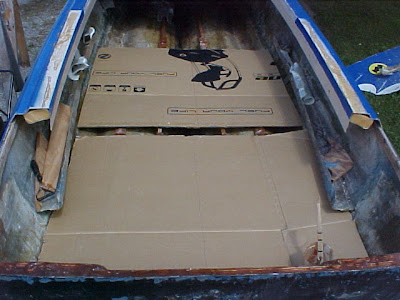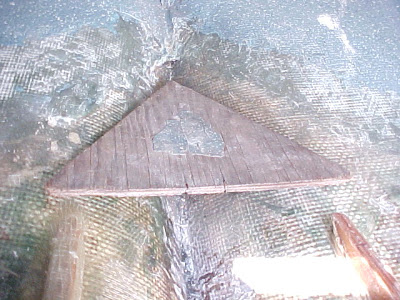
Now that the construction adhesive had bonded all the stringers in the hull my goals for today were to lay fiberglass on the two cross braces and two of the stringers.
I have to take a day off between work on the
Batboat because all of the bending and putting myself in odd positions in the hull leaves me stiff and sore, especially in the lower back. Wearing my weight lifting belt helps out a lot. Its worn from this day on.

Again, screws at the ends are supporting the brace
plys on the saw horses. Here they are wet down with polyester resin. I laid the 1.5 oz chopped strand mat on top and rolled them on using a fiberglass roller.

The finished product. At the end of the day both sides were protected and water proofed with fiberglass. I'll grind all the excess off another day after the resin is completely set.

Lengths of 1708
biaxial fiberglass cloth were cut for
fiberglassing over two of the stringers. I was doing one side of the hull one day at a time so cloth was cut for the other two for another day but I didn't have enough left. Five more yards of1708 was ordered that morning so no big deal.

This stuff is many times more stronger than what was originally used by the factory. More on this later. The width of it laying on the hull makes the boat stronger, also.

To fiberglass the cloth over the stringers a lot of polyester resin is spread over the ply and the hull where the cloth goes. It is then shaped around the stringers and
rolled with a fiberglass roller.
That thick 1708 cloth soaks in a great deal of resin! More resin was pained on top and rolled until it became transparent.



1708
biaxial fiberglass cloth does not bend around edges very well but in this case the small stringer turned out good.

The five gallon bucket of resin was almost empty but it wouldn't pour out of the dang thing. A few holes were knocked in the bottom with a crowbar and the rest dripped out into another container. I ended up with 16 oz. more resin to use which otherwise would have gone to waste. This stuff is expensive costing up to $50 per gallon depending on shipping charges.

I hate getting resin in a five gallon bucket!
After mixing it with the
MEKP activator, I wet down the long stringer, mixed more up and began glassing the cloth in.
A big mistake was made here that I hope will help you out if you are making your own
Batboat. I started glassing in the long stringer
beginning from the transom and worked my way into the bow. This got me into some sticky situations with my
Tyvek suit. On the way in and out I
accidentally stood, sat, and
kneeled into the work I had done. It is best to start at the bow and work your way back.
The seat and feet of my suit frequently got stuck to the hull. Days later I had to use my grinder to get the shreds of material out!

Here is the suit. The seat and crotch is split out and feet gone.

Some of the 1708 cloth lengths were slightly misshaped at the ends before I glassed them in. At first I thought they would lay flat when soaked with resin but so such luck. Those spots will have to be ground out and patched with more 1708.

Be careful not to get odd pulls in the weave of your woven
biaxial fiberglass cloth. This is what it looked like a day or two later.

This bubble surely has to be ground out and fixed with a patch of 1708.

With exception for some odd scraps, I was out of 1708
biaxal and got this far up the stringer. Halfway up the end section under the bow.
At this point my
Tyvek suit was torn to shreds, parts were stuck to the hull, I ran out of 1708, and the low class,
stoner neighbor's dog had been barking for three or four consecutive hours. With no more areas to glass in I threw the container with 12 oz. resin left in it across the yard.
Frustrated, I was done for the day!





























































